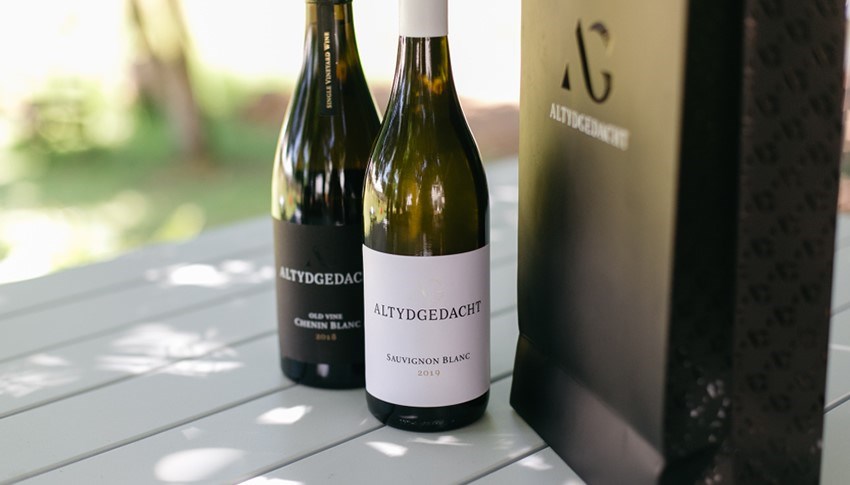Sitting amongst dense vegetation it was perhaps harshly described by Napoleon’s secretary, staying for three months before returning to Europe, like “being removed to the very extremity of the civilised world”, it took an uncomfortable half day’s journey to get into Cape Town.
Arriving as settlers in 1819, the Parker family acquired the estate in 1852, and today, John and Oliver Parker are the fifth generation on the farm.
With three centuries of winemaking on the estate, it abounds with relics of the past and is unashamedly rustic and informal. The old cellar stands among a warren of thick-walled rooms, here decades old cement tanks still in use, there the broken floor and worn stairs of a cellar that winemaker Etienne Louw says gets so cold in winter that workers used to light indoor fires to keep warm.
Etienne is in his thirteenth vintage at Altydgedacht and though there is much pride in the history and continuity of the farm, there have been many changes along the way and today those changes are significant.
“The biggest enemy of a winemaker”, says Etienne, “is resistance to change”. He and new Marketing and Sales Manager, Monique Brown, are energised by the plans before them.
Altydgedacht is known for a range of varietals, some of which are less common, like Gewurztraminer, Muscat, and especially the popular Barbera (“the on-trade were the first to understand Barbera”, says Etienne). When Etienne started it was a farm that mostly provided grapes and wine for others, perhaps using just 20% of its production itself, and he inherited 16 different varietals spread over some 200 hectares. Gradual selection, sales and refinement since 2008 have reduced that to around 70 hectares under vine.

With new partners joining the family in 2018 the changes gained impetus. “There was never any question of the grape quality or wine quality”, says Etienne, but they needed to focus on what they did best and that prompted a rethink. The soils were perfect, being fertile and free-draining red Hutton and Clovelly mostly, with pockets of vines having serious climatic differences, being just 12km from the ocean. “Near me there are Pinotage vines facing north and just behind them Sauvignon Blanc facing the gentle down slope southwards”. Sadly the one – yes one –hectare of Barbera that was planted in 1927 and used for fortified sweet red wine from the 1930’s to 1950’s and which was at the time the only remaining block in South Africa, has gone, to be replaced by better placed vines elsewhere.
“It’s important to offer something different, otherwise you’re just another bar of soap, the wine industry is so dynamic”, says Etienne, “and I love a challenge”.
That new focus required an in-depth charting of the vineyards, looking at matching soils with varieties and clones. There was some grubbing-up, around 5 hectares, and new plantings are planned. The 46 year old Chenin Blanc bush vines are staying, despite their two tonnes per hectare yield. “Is Durbanville right for Chenin”, I ask, “in the right spot it is, ours has distinctive flavours of spice, citrus and cedar, and the area is seeing more Chenin being planted”.
Other than their nervous tension for the following week’s labelling, Monique and Etienne, and another key figure in the team, the experienced General Manager Debra Savage, are in the middle of re-branding. “I’ve just started and it’s clear I’m going to learn so much from Debra”, says Monique, “she’s so precise and doesn’t miss any details, she’s amazing”, and Etienne adds that they are very serious about the re-branding and that it’s a privilege to work with Debra.
So now there is a new logo, new labels and focused brands, some varietals will not be produced again until their key brands like the Pinotage, MCC and Barbera are established.
The MCC is a good example of innovation amongst the continuity. A brut style Blanc de Blanc with some 17 months on the lees, Etienne didn’t make three vintages of it after the first, “because I wanted to see how it would turn out. It was the Grand Prix winner at the 2015 MCC Challenge so I’ve carried on since!” Another change is going back to cork from screwcap for their Gewurztraminer.
What strikes you at Altydgedacht is both the unbroken history and artefacts of the estate, carefully nurtured by the Parker family (“they have a huge sense of preservation” says Etienne) and the modern outlook and plans for the future. It is a nice juxtaposition, the wedding functions and zip-lining amongst the horses and battered wine presses, the lineage of the Barbera saved by Italian workers before the second world war and the modern minimalist signage and canopies over the newly arrived guest tables.
No-one is relying on history here, Etienne says “you must embrace change” and these two are up for the challenge, but if you want to speak to Etienne about it you might need to get to Port Elizabeth as this classically trained guitarist is performing his first rock gig there. There’s that juxtaposition again, the 1702 cellar and the Fender Strat.
For more, visit www.altydgedacht.co.za